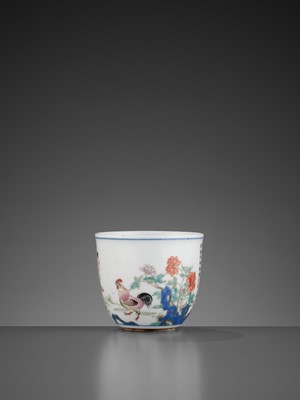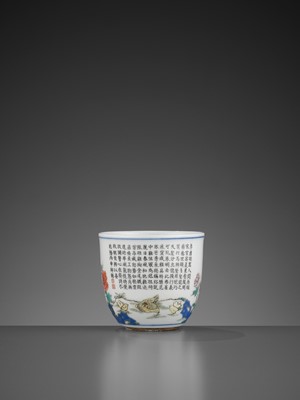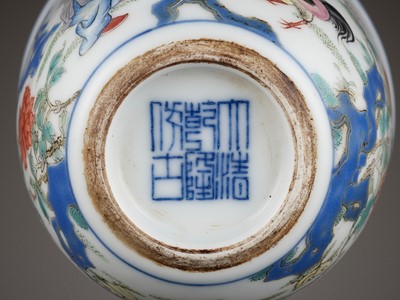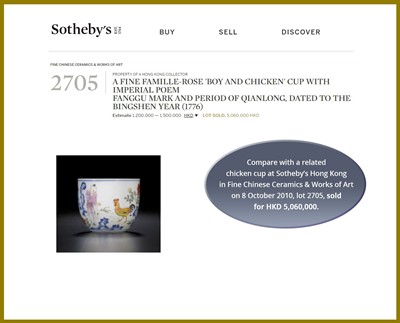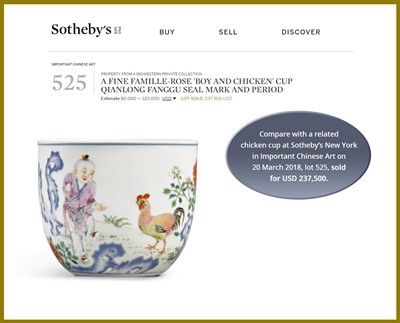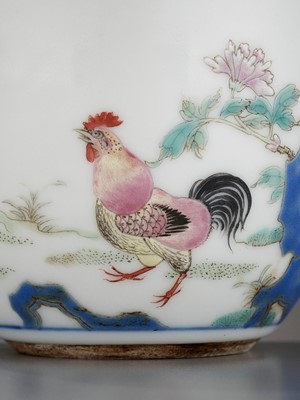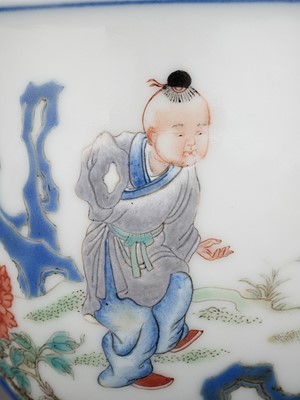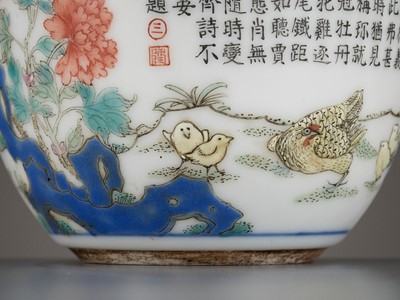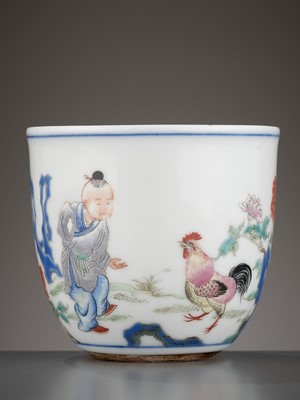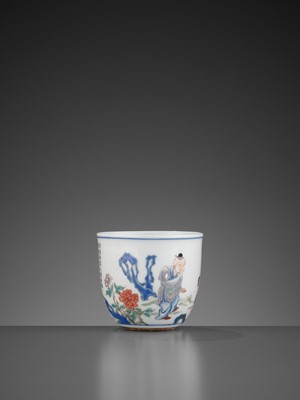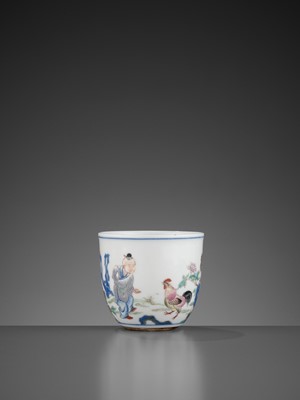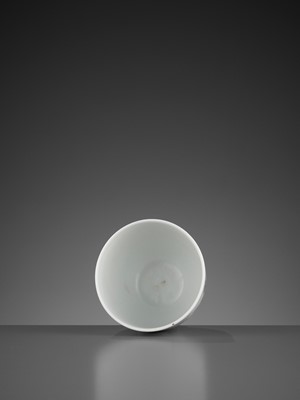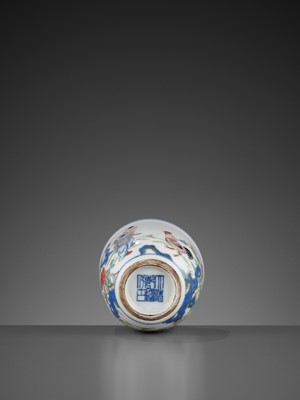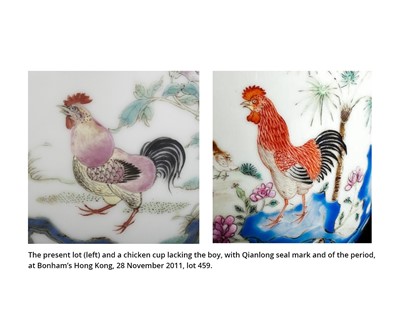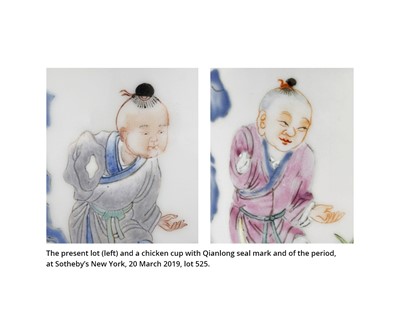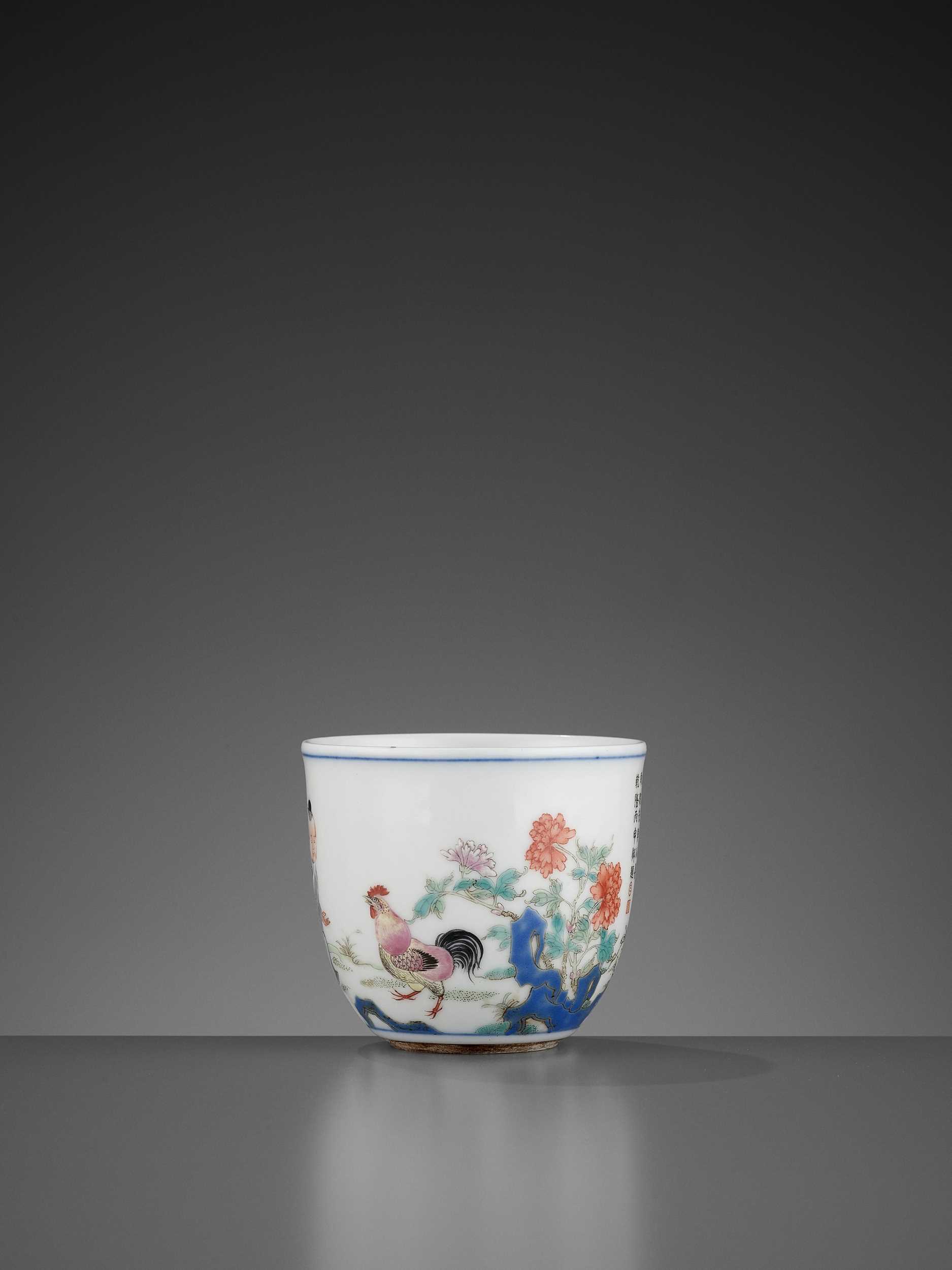5th Mar, 2021 10:00
TWO-DAY AUCTION - Fine Chinese Art / 中國藝術集珍 / Buddhism & Hinduism
254
A FAMILLE ROSE PORCELAIN ‘CHICKEN’ CUP, QING DYNASTY
清代粉彩童子戯鷄杯
Sold for €6,952
including Buyer's Premium
China, 1776-1880. Inscribed with an imperial poem by the Qianlong Emperor and dated to the bingshen year of the Qianlong reign, corresponding to 1776. The base inscribed with a six-character Da Qing Qianlong fanggu seal mark in underglaze blue, and possibly of the period.
Provenance: From the estate of the Loh family, Los Angeles, USA. Collected in Singapore from 1945 to 1955, and in the same family for over 65 years. Thence by descent to the present owner.
Condition: Excellent condition with minor wear and light surface scratches, one small pit to the rim.
Weight: 131.5 g
Dimensions: Height 7.3 cm, Diameter 8.2 cm
Finely potted with steep rounded sides rising from a recessed base to a slightly everted rim. Finely painted to the exterior with a boy approaching a rooster, a hen tending four small chicks, the scene further decorated with craggy rocks, blooming peonies and roses.
Cups of this type are based on earlier Chenghua doucai prototypes, such as the pair of similar shape, but decorated with chickens only, included in the Illustrated Catalogue of Chinese Government Exhibits for International Exhibition of Chinese Art in London, vol. II, Porcelain, 1948, p. 130, no. 171. The poem inscribed on the present cup acknowledges that the design is an adaptation of the earlier chicken cups. For a translation of the poem and a description of the subject, see the exhibition catalog, For the Imperial Court: Qing Porcelain from the Percival David Foundation of Chinese Art, Kimbell Art Museum, Fort Worth Tex., 1997, p. 98.
The mark on the base of all these cups reads Da Qing Qianlong fanggu, which translates as 'made in imitation of antiquity in the Qianlong reign of the Great Qing dynasty'. The imitation of antiquity, or archaism, was a theme close to the Qianlong emperor's heart and a considerable number of imperial art objects in a range of different media bear this mark.
The poem inscribed on the cups mentions a man by the name of Zang Ping, who lived during the Muzong reign (reigned AD 926-33) of the Tang dynasty. Zang was famous for the large cockerels he reared to take part in the cockfights that took place during the Qing Ming festival. However, the youth depicted on the cups may instead represent Jia Chang (born AD 713), who was a child prodigy. At the age of thirteen he was such a talented trainer of fighting cocks that the Tang dynasty emperor Xuanzong (reigned AD 713-56) employed him to train the imperial fighting cocks. The design on these cups is therefore often known as 'the precocious boy'.
Expert’s note: There are two differences between the present lot and the more common series of mark and period chicken cups: The boy is painted with an attention to detail arguably more elaborate and the rooster resembles one from a group of cups that show only chickens but no boy. While these findings may not represent much of an argument against firmly dating the present cup to 1776, we still decided to extend the dating into the later Qing period until further research dedicated to these differences can be conducted.
Literature comparison: A related example was included in the exhibition Joined Colors, Arthur M. Sackler Gallery, Smithsonian Institution, Washington D.C., 1993, cat. no. 64; another, in the Sir Percival David foundation in the British Museum, London, was included in the exhibition For the Imperial Court: Qing Porcelain from the Percival David Foundation of Chinese Art, Kimbell Art Museum, Fort Worth Tex., 1997, cat. no. 33; and a pair of cups in the National Palace Museum, Taiwan, was included in the Special Exhibition of K'ang-hsi, Yung-cheng and Ch'ien-lung Porcelain Ware from the Ch'ing Dynasty in the National Palace Museum, National Palace Museum, Taipei, 1986, cat. no. 144.
Auction result comparison: Compare with a related chicken cup at Sotheby’s New York in Important Chinese Art on 20 March 2018, lot 525, sold for USD 237,500, and another at Sotheby’s Hong Kong in Fine Chinese
Ceramics & Works of Art on 8 October 2010, lot 2705, sold for HKD 5,060,000.
清代粉彩童子戯鷄杯
中國, 1776-1880年。杯上可見乾隆帝題詩可見“丙申“年,即1776。杯底可見乾隆青花六字款。
來源:來自美國洛杉磯Loh氏家族。 1945年至1955年在新加坡收集,並在同一個家族保存65年以上,直至進入現任藏家手中。
品相:狀況極佳,磨損小,表面輕微划痕,邊沿上有一個小凹坑。
重量:131.5 克
尺寸:高 7.3 厘米,直徑8.2 厘米
拍賣結果比較:一件相似童子戲雞杯,售于紐約蘇富比 Important Chinese Art 拍場,2018年3月20日, lot 525, 售價USD 237,500;另一件售于香港蘇富比 Fine Chinese Ceramics & Works of Art拍場,2010年10月8日,lot 2705, 售價HKD 5,060,000。
China, 1776-1880. Inscribed with an imperial poem by the Qianlong Emperor and dated to the bingshen year of the Qianlong reign, corresponding to 1776. The base inscribed with a six-character Da Qing Qianlong fanggu seal mark in underglaze blue, and possibly of the period.
Provenance: From the estate of the Loh family, Los Angeles, USA. Collected in Singapore from 1945 to 1955, and in the same family for over 65 years. Thence by descent to the present owner.
Condition: Excellent condition with minor wear and light surface scratches, one small pit to the rim.
Weight: 131.5 g
Dimensions: Height 7.3 cm, Diameter 8.2 cm
Finely potted with steep rounded sides rising from a recessed base to a slightly everted rim. Finely painted to the exterior with a boy approaching a rooster, a hen tending four small chicks, the scene further decorated with craggy rocks, blooming peonies and roses.
Cups of this type are based on earlier Chenghua doucai prototypes, such as the pair of similar shape, but decorated with chickens only, included in the Illustrated Catalogue of Chinese Government Exhibits for International Exhibition of Chinese Art in London, vol. II, Porcelain, 1948, p. 130, no. 171. The poem inscribed on the present cup acknowledges that the design is an adaptation of the earlier chicken cups. For a translation of the poem and a description of the subject, see the exhibition catalog, For the Imperial Court: Qing Porcelain from the Percival David Foundation of Chinese Art, Kimbell Art Museum, Fort Worth Tex., 1997, p. 98.
The mark on the base of all these cups reads Da Qing Qianlong fanggu, which translates as 'made in imitation of antiquity in the Qianlong reign of the Great Qing dynasty'. The imitation of antiquity, or archaism, was a theme close to the Qianlong emperor's heart and a considerable number of imperial art objects in a range of different media bear this mark.
The poem inscribed on the cups mentions a man by the name of Zang Ping, who lived during the Muzong reign (reigned AD 926-33) of the Tang dynasty. Zang was famous for the large cockerels he reared to take part in the cockfights that took place during the Qing Ming festival. However, the youth depicted on the cups may instead represent Jia Chang (born AD 713), who was a child prodigy. At the age of thirteen he was such a talented trainer of fighting cocks that the Tang dynasty emperor Xuanzong (reigned AD 713-56) employed him to train the imperial fighting cocks. The design on these cups is therefore often known as 'the precocious boy'.
Expert’s note: There are two differences between the present lot and the more common series of mark and period chicken cups: The boy is painted with an attention to detail arguably more elaborate and the rooster resembles one from a group of cups that show only chickens but no boy. While these findings may not represent much of an argument against firmly dating the present cup to 1776, we still decided to extend the dating into the later Qing period until further research dedicated to these differences can be conducted.
Literature comparison: A related example was included in the exhibition Joined Colors, Arthur M. Sackler Gallery, Smithsonian Institution, Washington D.C., 1993, cat. no. 64; another, in the Sir Percival David foundation in the British Museum, London, was included in the exhibition For the Imperial Court: Qing Porcelain from the Percival David Foundation of Chinese Art, Kimbell Art Museum, Fort Worth Tex., 1997, cat. no. 33; and a pair of cups in the National Palace Museum, Taiwan, was included in the Special Exhibition of K'ang-hsi, Yung-cheng and Ch'ien-lung Porcelain Ware from the Ch'ing Dynasty in the National Palace Museum, National Palace Museum, Taipei, 1986, cat. no. 144.
Auction result comparison: Compare with a related chicken cup at Sotheby’s New York in Important Chinese Art on 20 March 2018, lot 525, sold for USD 237,500, and another at Sotheby’s Hong Kong in Fine Chinese
Ceramics & Works of Art on 8 October 2010, lot 2705, sold for HKD 5,060,000.
清代粉彩童子戯鷄杯
中國, 1776-1880年。杯上可見乾隆帝題詩可見“丙申“年,即1776。杯底可見乾隆青花六字款。
來源:來自美國洛杉磯Loh氏家族。 1945年至1955年在新加坡收集,並在同一個家族保存65年以上,直至進入現任藏家手中。
品相:狀況極佳,磨損小,表面輕微划痕,邊沿上有一個小凹坑。
重量:131.5 克
尺寸:高 7.3 厘米,直徑8.2 厘米
拍賣結果比較:一件相似童子戲雞杯,售于紐約蘇富比 Important Chinese Art 拍場,2018年3月20日, lot 525, 售價USD 237,500;另一件售于香港蘇富比 Fine Chinese Ceramics & Works of Art拍場,2010年10月8日,lot 2705, 售價HKD 5,060,000。
Zacke Live Online Bidding
Our online bidding platform makes it easier than ever to bid in our auctions! When you bid through our website, you can take advantage of our premium buyer's terms without incurring any additional online bidding surcharges.
To bid live online, you'll need to create an online account. Once your account is created and your identity is verified, you can register to bid in an auction up to 12 hours before the auction begins.
Intended Spend and Bid Limits
When you register to bid in an online auction, you will need to share your intended maximum spending budget for the auction. We will then review your intended spend and set a bid limit for you. Once you have pre-registered for a live online auction, you can see your intended spend and bid limit by going to 'Account Settings' and clicking on 'Live Bidding Registrations'.
Your bid limit will be the maximum amount you can bid during the auction. Your bid limit is for the hammer price and is not affected by the buyer’s premium and VAT. For example, if you have a bid limit of €1,000 and place two winning bids for €300 and €200, then you will only be able to bid €500 for the rest of the auction. If you try to place a bid that is higher than €500, you will not be able to do so.
Online Absentee and Telephone Bids
You can now leave absentee and telephone bids on our website!
Absentee Bidding
Once you've created an account and your identity is verified, you can leave your absentee bid directly on the lot page. We will contact you when your bids have been confirmed.
Telephone Bidding
Once you've created an account and your identity is verified, you can leave telephone bids online. We will contact you when your bids have been confirmed.
Classic Absentee and Telephone Bidding Form
You can still submit absentee and telephone bids by email or fax if you prefer. Simply fill out the Absentee Bidding/Telephone bidding form and return it to us by email at office@zacke.at or by fax at +43 (1) 532 04 52 20. You can download the PDF from our Upcoming Auctions page.
How-To Guides
How to Create Your Personal Zacke Account
How to Register to Bid on Zacke Live
How to Leave Absentee Bids Online
How to Leave Telephone Bids Online
中文版本的操作指南
创建新账号
注册Zacke Live在线直播竞拍(免平台费)
缺席投标和电话投标
Third-Party Bidding
We partner with best-in-class third-party partners to make it easy for you to bid online in the channel of your choice. Please note that if you bid with one of our third-party online partners, then there will be a live bidding surcharge on top of your final purchase price. You can find all of our fees here. Here's a full list of our third-party partners:
- 51 Bid Live
- EpaiLive
- ArtFoxLive
- Invaluable
- LiveAuctioneers
- the-saleroom
- lot-tissimo
- Drouot
Please note that we place different auctions on different platforms. For example, in general, we only place Chinese art auctions on 51 Bid Live.
Bidding in Person
You must register to bid in person and will be assigned a paddle at the auction. Please contact us at office@zacke.at or +43 (1) 532 04 52 for the latest local health and safety guidelines.
